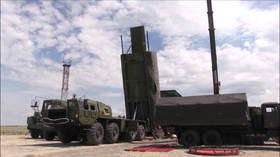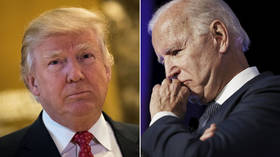As the US pressures Russia to renegotiate the New START Treaty, it exposes its own unreliability as a negotiating partner
The US seeks to pressure Russia by threatening to reactivate nuclear capability mothballed under the New START treaty if Moscow refuses to renegotiate. All it will accomplish by this is prove it habitually cheats on arms control.
According to Politico, “The Trump administration has asked the military to assess how quickly it could pull nuclear weapons out of storage and load them onto bombers and submarines” when the New START treaty limiting the size of the US and Russian strategic nuclear arsenals expires in February. Politico sources its story “to three people familiar with the discussions.” According to these sources, the request was made to the US Strategic Command as “part of a strategy to pressure Moscow into renegotiating the New Strategic Arms Reduction Treaty before the US presidential election.”
What is curious about this report is that US Strategic Command already knows the answer to the request. To meet the level of warhead reductions mandated under the treaty, the US has decreased the number of warheads carried on the Minuteman III intercontinental ballistic missile (ICBM) from three to one, and on its Trident D-5 submarine-launched ballistic missile (SLBM) from up to 14 to around 5 or 6.
The deactivated warheads were reclassified as either active or inactive. Active warheads are kept fully assembled and subjected to the same level of maintenance and upgrades as their operational counterparts, and can be reactivated in accordance with guidelines already established by US Strategic Command. Inactive warheads have been partially disassembled, and their reactivation would take longer than for their active counterparts, but is similarly regulated by US Strategic Command directives. Moreover, the US regularly conducts tests where it reconverts the Minuteman III ICBM to a three-warhead configuration to practice for the very activities suggested in the Politico article. The timelines associated with this reconversion are well known to US Strategic Command. It is not publicly known whether the US Navy conducts similar re-conversion flight tests of its Trident D-5 SLBMs.
One aspect of this request that, if it were implemented, would fall outside the existing reactivation guidelines set by US Strategic Command is if the US were to reconvert its fleet of Trident ballistic missile submarines from its current configuration under New START to one where no restrictions applied. This possibility raises some interesting questions about US compliance with New START.
According to Section 1, paragraph 3 in Part Three of the Protocol to the treaty,
“If an ICBM launcher, SLBM launcher, or heavy bomber is converted by rendering it incapable of employing ICBMs, SLBMs, or nuclear armaments, so that the other Party can confirm the results of the conversion, such a converted strategic offensive arm shall cease to be subject to the aggregate numbers provided for in Article II of the Treaty and may be used for purposes not inconsistent with the Treaty.”
To meet its obligations under New START, the US converted four SLBM launchers on each of its 14 Trident ballistic missile submarines – a total of 56 – to remove them from the permitted number of launchers. This conversion was done by removing the gas generators of the ejecting mechanism from the launch tube and bolting the tube covers shut.
On February 27, 2018, the Russian Foreign Ministry protested the American actions, noting that, in regard to the Trident conversions, they were “converted in such a way that the Russian Federation cannot confirm that these strategic arms have been rendered incapable of employing SLBMs.”
The Russians were concerned that the Trident SLBM conversions were not irreversible, as required under the terms of the treaty, and that the 56 launchers listed as having been “rendered incapable of employing SLBMs” should rather have been categorized as “non-deployed launchers” and not excluded from the total aggregate count. To put it bluntly, the Russians were accusing the United States of cheating on the New START Treaty.
Also on rt.com US envoy says Russia must agree to arms control deal with no NATO scaleback, or else it’s ‘happy to modernize nukes without START’If true, the threat made by Marshall Billingslea in his interview with the Russian Kommersant paper on September 21 to “reconvert our weapons”, if applied to the Trident ballistic missile submarine launch tubes, would not only confirm the Russian suspicions, but certify the US as an untrustworthy negotiating partner in any future arms control negotiations, either with Russia or China.
Washington already has one strike against it in this regard: its contention that the Mk 41 launcher used on the Aegis Ashore anti-ballistic missile system could not be used as a cruise missile launcher, and, as such, did not constitute a violation of the Intermediate-Range Nuclear Forces (INF) Treaty. This was shown to be a lie when, less than a month after the US withdrew from the INF Treaty, it conducted a flight test of a cruise missile fired from the same Mk 41 launcher.
If the Politico reporting is accurate, the US military has been ordered to carry out an exercise that is redundant insofar as the data is already known, and which does nothing to further US strategic capabilities. Moreover, if the US plans on increasing its SLBM launch capability by reactivating the 56 SLBM launchers ostensibly rendered inoperable under New START, Marshall Billingslea would be undermining his own stated objective of trying to pressure Russia back to the negotiating table before the November 2020 presidential election. After all, who in their right mind would be willing to negotiate with a proven cheater?
Think your friends would be interested? Share this story!
The statements, views and opinions expressed in this column are solely those of the author and do not necessarily represent those of RT.

















